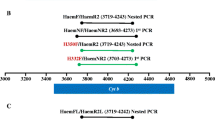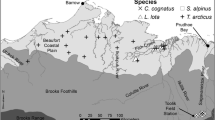Abstract
Pathogen-free rainbow trout (Oncorhynchus mykiss) aged 735 degree days were experimentally exposed to a low dose of infectious Myxobolus cerebralis (20 triactinomyxons fish−1). Three time periods were chosen for sampling that included 10 days (d), 67 d, and 5 months (mo) post exposure. Five diagnostic assays were used: (1) conventional single-round polymerase chain reaction (PCR), (2) nested PCR, (3) real-time TaqMan PCR, (4) pepsin–trypsin digest, and (5) histopathology. M. cerebralis was detected among individual rainbow trout by all of the PCR diagnostic tests employed at each of the three sampling time points. This result demonstrates that any of these three diagnostic approaches are capable of detecting the parasite from infected fish tissues under the conditions tested. Real-time PCR provided good biological evidence that parasite replication increases temporally as shown by quantification values that were significantly different (P<0.0001) at 10 d as compared to 67 d and 5 mo postexposure. Although sampling at 10 d by real-time PCR may be too early to accurately predict quantities of the parasite that will be present at 5 mo, it does forecast the proportions of fish that are likely to be infected at 67 d and 5 mo postparasite exposure. Real-time PCR could potentially be used as a quantitative diagnostic PCR tool to predict parasite load and outcome of M. cerebralis infection.



Similar content being viewed by others
References
American Fisheries Society–Fish Health Section (2004) FHS bluebook: suggested procedures for the detection and identification of certain finfish and shellfish pathogens, 2004 edn. AFS–FHS, Bethesda, Maryland
Andree KB, Gresoviac SJ, Hedrick RP (1997) Small subunit ribosomal RNA sequences unite alternate actinosporean and myxosporean stages of Myxobolus cerebralis, the causative agent of whirling disease in salmonid fish. J Eukaryot Microbiol 44:208–215
Andree KB, MacConnell E, Hedrick RP (1998) A nested polymerase chain reaction for the detection of genomic DNA of Myxobolus cerebralis in rainbow trout Oncorhynchus mykiss. Dis Aquat Organ 34:145–154
Antonio DB, Andree KB, McDowell TS, Hedrick RP (1998) Detection of Myxobolus cerebralis in rainbow trout and oligochaete tissues by using a non-radioactive in situ hybridization (ISH) protocol. J Aquat Anim Health 10:338–347
Baldwin TJ, Myklebust KA (2002) Validation of a single round polymerase chain reaction assay for identification of Myxobolus cerebralis myxospores. Dis Aquat Organ 49:185–190
Baldwin TJ, Vincent ER, Silflow RM, Stanek D (2000) Myxobolus cerebralis infection in rainbow trout (Oncorhynchus mykiss) and brown trout (Salmo trutta) exposed under natural stream conditions. J Vet Diagn Invest 12:312–321
Bartholomew JL, Reno PW (2002) The history and dissemination of whirling disease. In: Bartholomew JL, Wilson JC (eds) Whirling disease: reviews and current topics. American Fisheries Society Symposium, vol 29. Bethesda, Maryland, pp 3–24
Beauchamp KA, Gay M, Kelley GO, El-Matbouli M, Kathman RD, Nehring RP, Hedrick RP (2002) Prevalence and susceptibility of infection to Myxobolus cerebralis, and genetic differences among populations of Tubifex tubifex. Dis Aquat Organ 51:113–121
Beauchamp KA, Kelley GO, Nehring B, Hedrick RP (2005) The severity of whirling disease among wild trout corresponds to the differences in genetic composition of Tubifex tubifex populations in central Colorado. J Parasitol 91:53–60
Cavender WP, Wood JS, Powell MS, Overturf K, Cain KD (2004) Real-time quantitative polymerase chain reaction (QPCR) to identify Myxobolus cerebralis in rainbow trout Oncorhynchus mykiss. Dis Aquat Organ 60:205–213
Cohen J (1960) A coefficient of agreement for nominal scales. Educ Psychol Meas 20:37–46
Dohoo I, Martin W, Stryhn H (2003) Chapter 5: screening and diagnostic tests. In: Veterinary epidemiologic research. Atlantic Veterinary College, Charlottetown, PE, Canada
El-Matbouli M, Hoffmann RW (1998) Light and electron microscopic study on the chronological development of Myxobolus cerebralis in Tubifex tubifex to the actinosporean stage triactinomyxon. Int J Parasitol 28:195–217
El-Matbouli M, Hoffmann RW, Mandok C (1995) Light and electron microscopic observations on the route of the triactinomyxon-sporoplasm of Myxobolus cerebralis from epidermis into rainbow trout cartilage. J Fish Biol 46:919–935
Hedrick RP, El-Matbouli M, Adkison MA, MacConnell E (1998) Whirling disease: re-emergence among wild trout. Immunol Rev 166:365–376
Kelley GO, Adkison MA, Leutenegger CM, Hedrick RP (2003) Myxobolus cerebralis: identification of a cathepsin Z-like protease gene (MyxCP-1) expressed during parasite development in rainbow trout, Oncorhynchus mykiss. Exp Parasitol 105:201–210
Kelley GO, Zagmutt-Vergara FJ, Leutenegger CM, Adkison MA, Baxa DV, Hedrick RP (2004a) Identification of a serine protease gene expressed by Myxobolus cerebralis during infection in rainbow trout (Oncorhynchus mykiss). Dis Aquat Organ 59:235–258
Kelley GO, Zagmutt-Vergara FJ, Leutenegger CM, Myklebust KA, Adkison MA, McDowell TS, Marty GD, Kahler AL, Bush AL, Gardner IA, Hedrick RP (2004b) Evaluation of five diagnostic methods for the detection and quantification of Myxobolus cerebralis. J Vet Diagn Invest 16:202–211
MacConnell E, Vincent ER (2002) The effects of Myxobolus cerebralis on the salmonid host. In: Bartholomew JL, Wilson JC (eds) Whirling disease: reviews and current topics. American Fisheries Society Symposium, vol 29. Bethesda, Maryland, pp 95–107
Markiw ME (1991) Whirling disease: earliest susceptible age of rainbow trout to the triactinomyxid of Myxobolus cerebralis. Aquaculture 92:1–6
Markiw ME (1992) Experimentally induced whirling disease. I. Dose response of fry and adults of rainbow trout exposed to the triactinomyxon stage of Myxobolus cerebralis. J Aquat Anim Health 4:40–43
Markiw ME, Wolf K (1974) Myxosoma cerebralis: isolation and concentration from fish skeletal elements—sequential enzymatic digestions and purification by differential centrifugation. J Fish Res Board Can 32:15–20
Markiw ME, Wolf K (1983) Myxosoma cerebralis (Myxozoa: Myxosporea) etiologic agent of salmonid whirling disease requires tubificid worms (Annelida: Oligochaetea) in its life cycle. J Protozool 30:561–564
Nehring RB, Walker PG (1996) Whirling disease in the wild: the new reality in the intermountain west. Fisheries (Bethesda) 21:3–28
Nehring RP, Thompson KG, Taurman K, Atkinson W (2003) Efficacy of passive sand filtration in reducing exposure of salmonids to the actinospore of Myxobolus cerebralis. Dis Aquat Organ 57:77–83
O’Grodnick JJ (1979) Susceptibility of various salmonids to whirling disease (Myxobolus cerebralis). Trans Am Fish Soc 108:187–190
R Development Core Team (2005) R: a language and environment for statistical computing. R Foundation for Statistical Computing, Vienna, Austria
Ryce E, Zale AV, MacConnell E (2004) Effects of fish age and parasite dose on the development of whirling disease in rainbow trout. Dis Aquat Organ 59:225–233
Schisler GJ, Bergersen EP, Walker PG (2001) Comparison of single-round polymerase chain reaction (PCR) methods for detection of Myxobolus cerebralis. Dis Aquat Organ 45:109–114
Thompson KG, Nehring RB, Bowden DC, Wygant T (1999) Field exposures of seven species or subspecies of salmonids to Myxobolus cerebralis in the Colorado River, Middle Park, Colorado. J Aquat Anim Health 11:312–329
Thompson KG, Nehring RB, Bowden DC, Wygant T (2002) Response of rainbow trout Oncorhynchus mykiss to exposure to Myxobolus cerebralis above and below a point source of infectivity in the upper Colorado River. Dis Aquat Organ 49:171–178
Vincent ER (1996) Whirling disease and wild trout: the Montana experience. Fisheries (Bethesda) 21:32–34
Wolf K, Markiw ME (1984) Biology contravenes taxonomy in the Myxozoa: new discoveries show alternation of invertebrate and vertebrate hosts. Science 225:1449–1452
Acknowledgements
This work was supported by the Montana Water Center, the US Fish and Wildlife Service, the Whirling Disease Foundation, and the California Department of Fish and Game. We also are grateful to K. Mukkatira and T. Waltzek for collecting parasite spores and maintaining oligochaete cultures. We also appreciate the assistance of the Lucy Whittier Molecular and Diagnostic Core Facility for the technical support.
Author information
Authors and Affiliations
Corresponding author
Rights and permissions
About this article
Cite this article
Kelley, G.O., Adkison, M.A., Zagmutt-Vergara, F.J. et al. Evaluation of quantitative real-time PCR for rapid assessments of the exposure of sentinel fish to Myxobolus cerebralis . Parasitol Res 99, 328–335 (2006). https://doi.org/10.1007/s00436-006-0166-3
Received:
Accepted:
Published:
Issue Date:
DOI: https://doi.org/10.1007/s00436-006-0166-3




